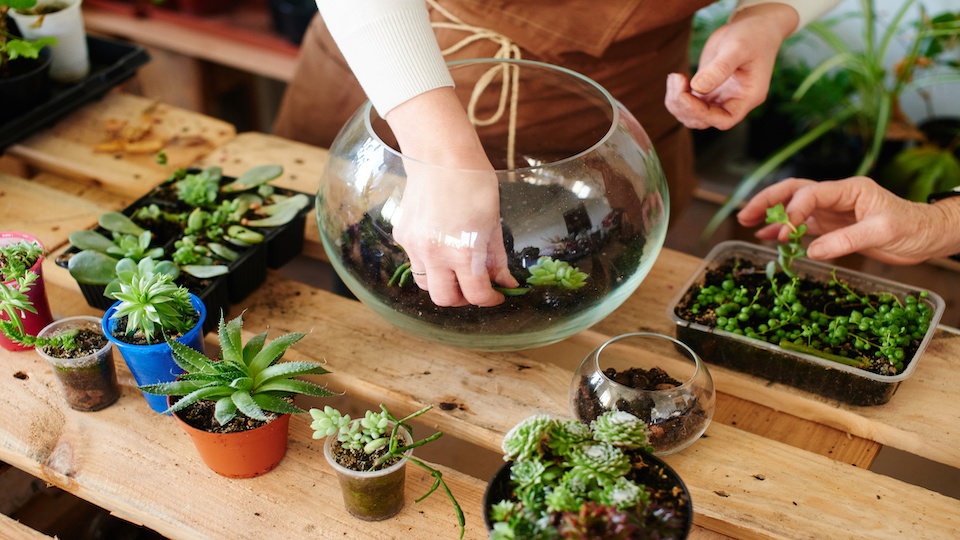Terrarium (Pl. terrariums/terraria) by definition is a miniature garden sealed in a glass container. They are excellent for displaying beautiful plants individually or as a composition that represents a piece of nature. They take a bit of effort to set up but are easy to maintain and add a beautiful and delicate touch to any space.
The first terrarium came into being by accident when a fern grew on its own in a closed glass container that English physician and botanist Nathaniel Ward had left aside. He went on to make several such glass cases for transporting and displaying exotic plants, and they soon became popular as Wardian cases.
To make your own terrarium:
Materials:
- Transparent container – Glass, acrylic or other clear plastic
- Terrarium plants – Mini Rex Begonias, Pilea, Peperomia, Selaginella, small ferns, moss, etc.
- Potting soil, sand/perlite
- Activated charcoal
- Rocks, pebbles, gravel, decorations
Tools: Long-handled spoon, tweezers/tongs, chopsticks, paper cone
Choose the right plants
Terrariums often fail because of wrong selection of plants. You might come across pictures of beautiful terrariums planted with succulents, but they usually remain picture-perfect for only a short while.
Being a closed environment, terrariums are typically humid and warm, similar to a tropical rainforest. There is limited space and light availability, too. Hence, choose plants that love warmth and humidity, do well in low light, and are compact and slow-growing.
Make a rough layout
Before you start setting up the terrarium, arrange the plants, rocks, and other decorations into a pleasing composition. Consider views from all sides. Mark their positions on a piece of paper or take several photos from different angles.
Prepare the container
- Clean the container thoroughly and dry it. It’s imperative that it is completely dry. Otherwise, when you add soil, it will stick to the walls and become too messy and difficult to clean.
- Add a layer of pebbles for drainage. This is to avoid the risk of plant roots sitting in wet soil and rotting. You can use pebbles of different colors and sizes to make up this layer, but altogether the drainage layer should ideally be 1-2 inches thick.
- Add a few pieces of charcoal or a ½ inch layer of activated charcoal granules over the drainage layer. It will help keep the soil and air sweet by neutralizing the odors due to bacterial decomposition of debris.
- Before adding the soil, place a layer of sphagnum moss to catch excess moisture and also to keep the soil off the lower layers.
- Add ¾ of the soil as the first layer. A well-draining mix of ½ potting soil and ½ sand/perlite is ideal.
Plant the terrarium
- Take out the plants from the pots, and gently shake off excess soil. Start planting from the middle for containers viewed from all sides.
- Use a pencil or chopsticks to make a small hole in the soil for each plant. Add more soil around it with a long-handled spoon and press down to fix it in place. You can use small rocks as additional support.
- After planting add moss or decorative pebbles to cover the soil surface.
- After all the plants and soil have been placed inside the container, clean the walls of the container. Use a paintbrush to gently brush away dirt from the glass as well as the plant leaves.
- Use a fine spray of water for the final clean up, but avoid excess amount. Wipe the walls clean with tissue paper.
Add decorations
Small figurines, tiny huts, mushrooms, etc., are often added to terrarium set-ups for visual interest.
Caring for your terrarium
- Keep the terrarium in a bright area but not in direct sunlight.
- Allow the container to remain open for 3-4 days so that excess water can evaporate.
- Put on the lid and watch the set up for signs of excess moisture. Small amounts of condensation are fine, but if you see too much water on the lid or running down the walls, leave the terrarium open for a few more days before sealing it shut.
- A sealed terrarium does not require a lot of maintenance. Nevertheless, your plants may need occasional pruning. Pick up decaying leaves or other debris from time to time.
Open terrariums
This variation of the typically closed terrarium is ideal for succulents and cacti which prefer a more arid environment and good air circulation. An open terrarium is also perfect for plants that need to be handled often, such as air plants that need regular soaking and drying or flowering and fast-growing plants that need frequent trimming.
Almost any glass container, from a small glass bowl to large aquarium tanks, may be turned into an open terrarium. It can also accommodate a wider variety of plants and can include climbing and trailing plants that may be allowed to spill out of the container.
Open terrariums, however, require more attention than a closed system, including regularly checking for soil moisture and watering when required. In short, they should be treated like any other container without drainage.
Why not invite some friends over for a terrarium planting party?
-Susan Patterson



